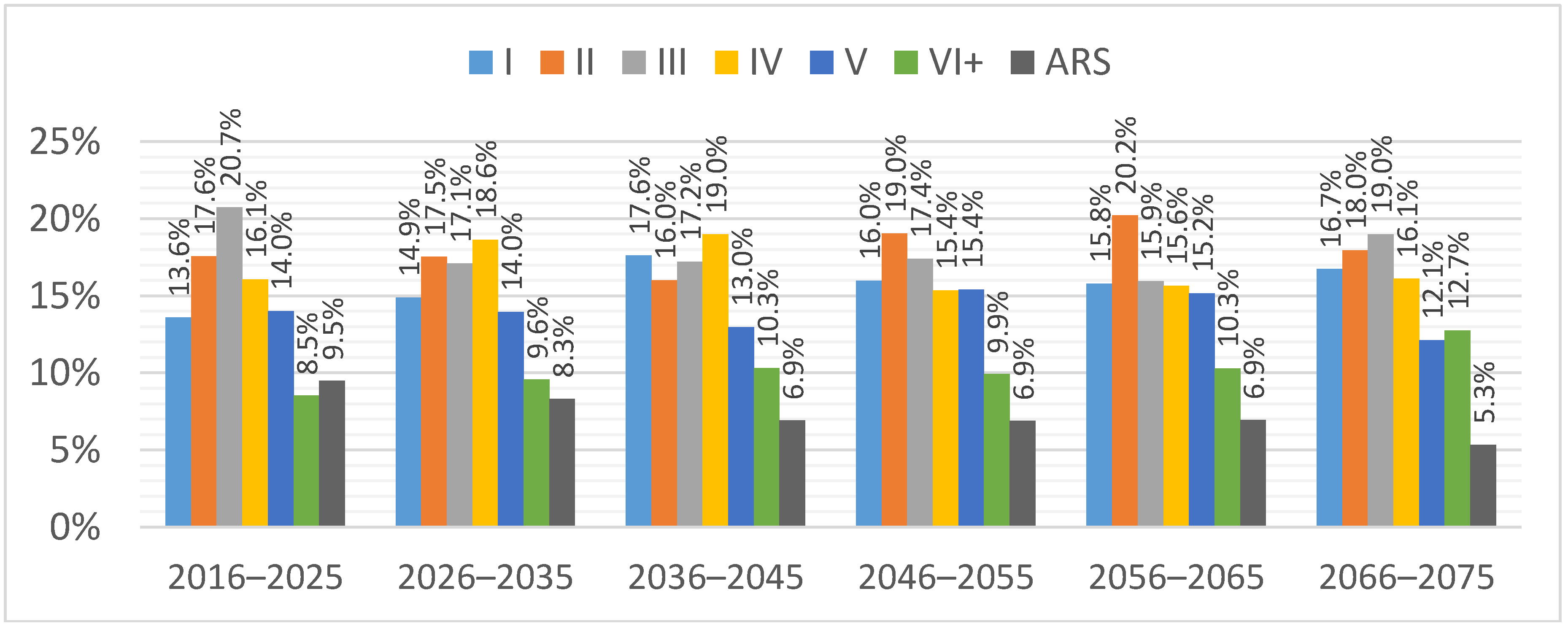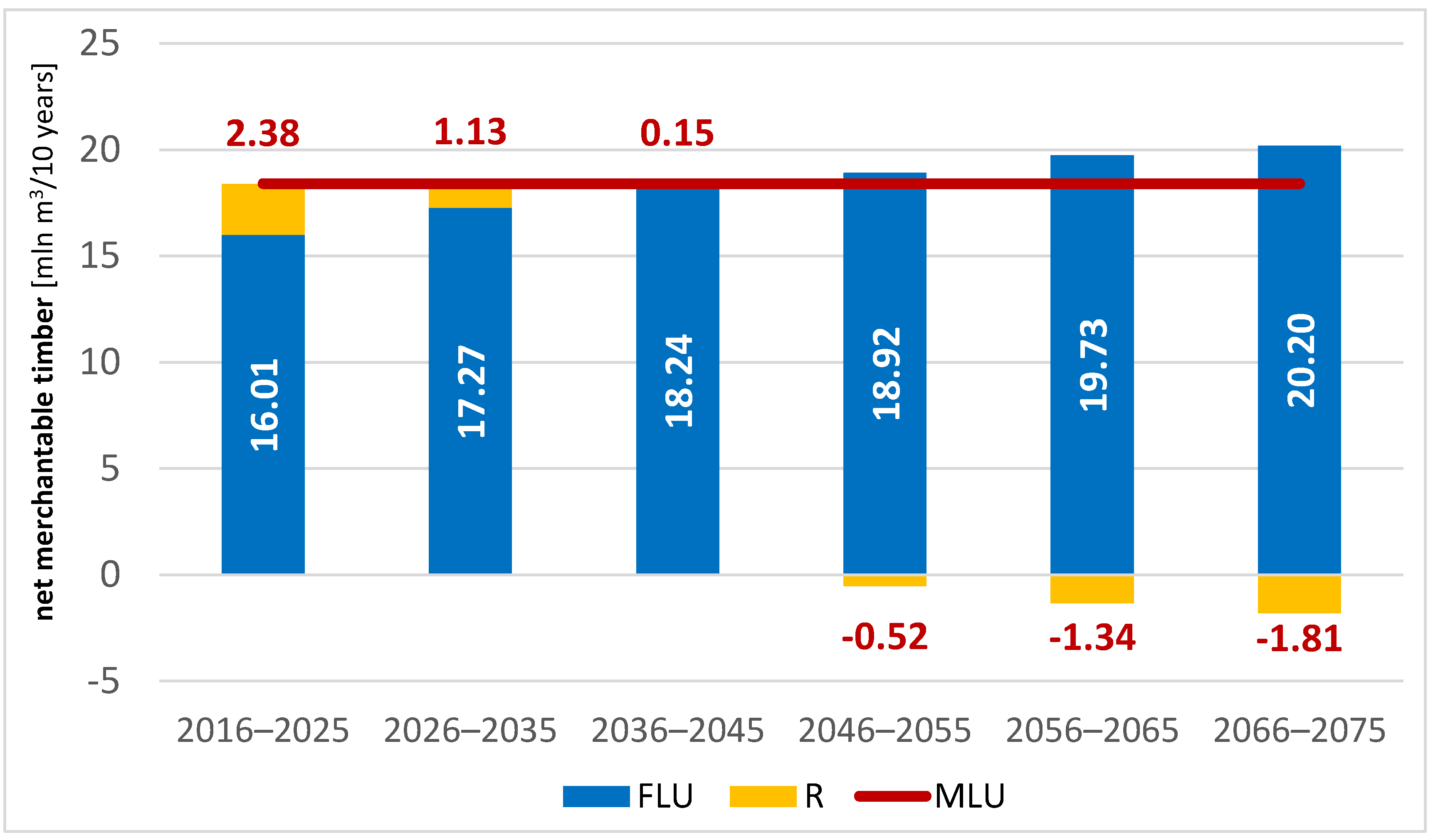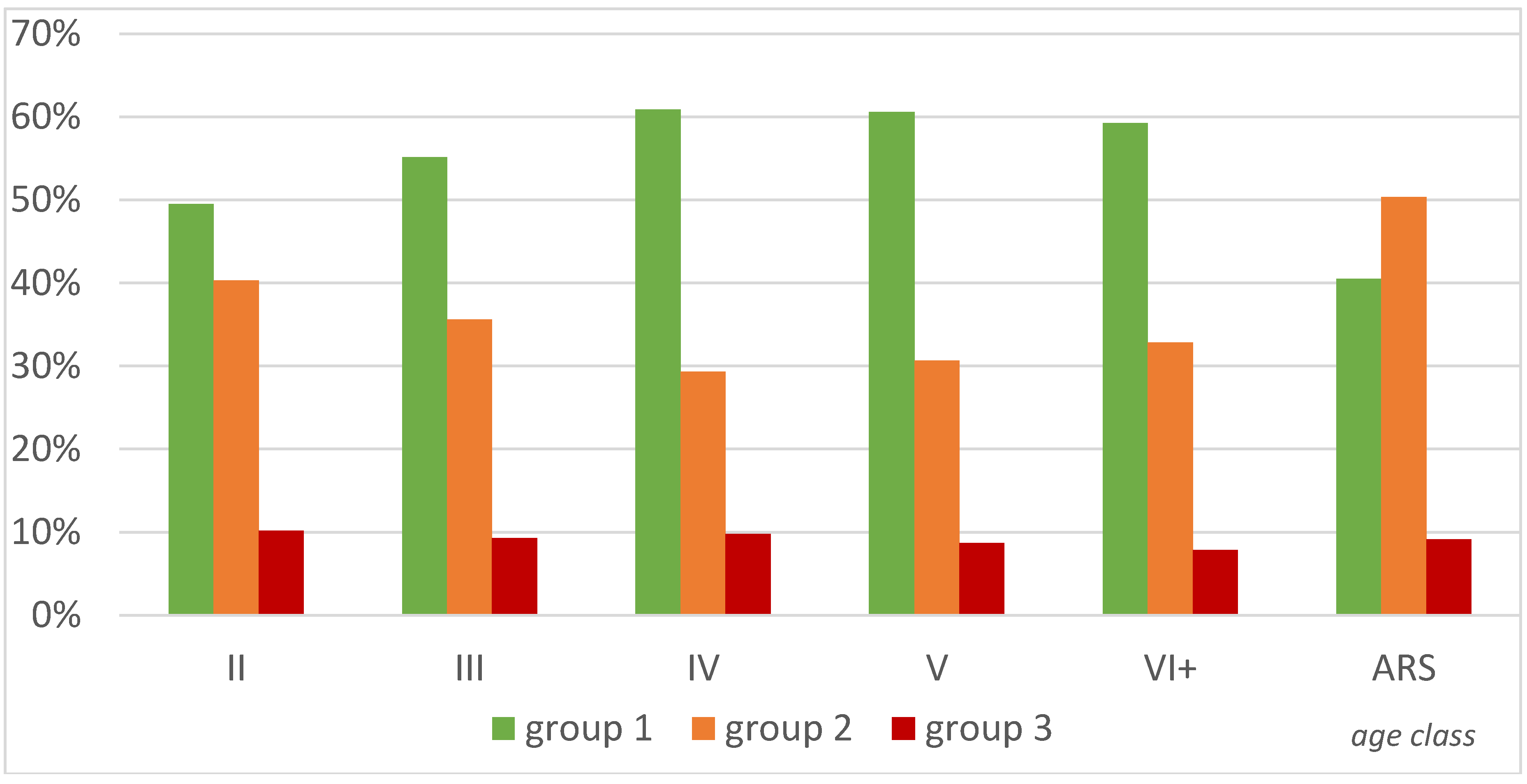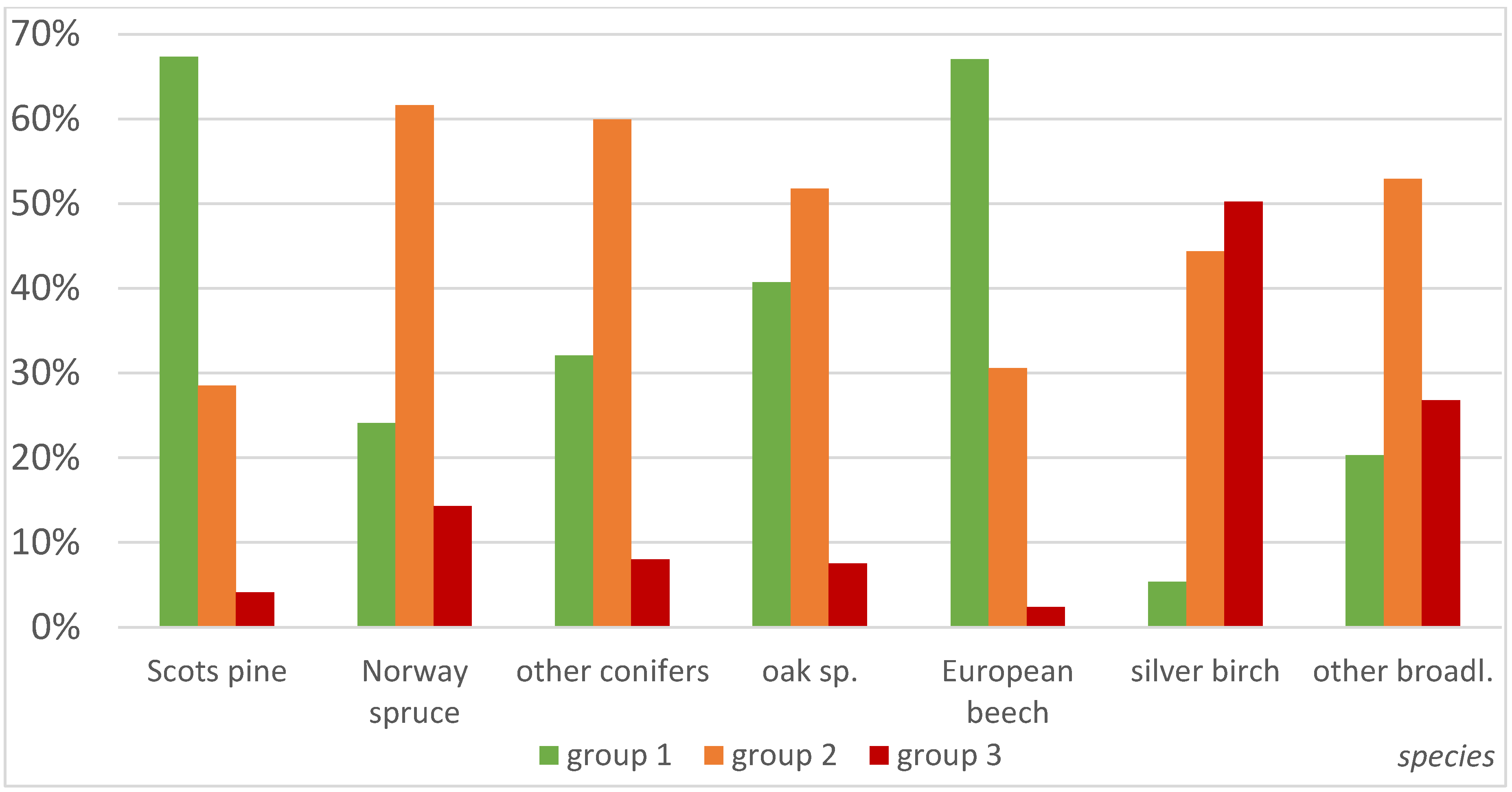The Concept of Regulating Forest Management in a Region Subject to High Environmental Pressure
Abstract
:1. Introduction
2. Materials and Methods
- MLUj—mean yield value determined for possible time periods of regulation “j,” for purpose of this study 2016–2075,
- FLUi—use forecast for 10-year forecast periods “i,”
- n—number of forecast periods, for purpose of this study (i = 6).
- the degree of achievement of the growing objective (characteristic A); a distinction was made between compliant (1), partially compliant (2) and non-compliant (3) grades,
- stability of stands (characteristic B); it was the resultant of 5 auxiliary partial determinants; stable (1), unstable (2) and endangered (3) conditions were distinguished,
- growing stock (characteristic C); was determined on the basis of 2 auxiliary determinants: good (1), medium (2) and poor (3) stock were distinguished.
- pijs—the share of species ‘i’ in stand ‘j’ of the habitat ‘s’,
- Mps—model size of the diversity index in the habitat ‘s.’
- group 1—111, 112, 121, 122, 211, 212,
- group 2—113, 123, 131, 132, 213, 221, 222, 311, 312.
- group 3—133, 223, 231, 232, 233, 313, 321, 322, 323, 331, 332, 333.
3. Results
3.1. Changes in the Age Structure
3.2. The Forecast of Yield Scope and Relative Uniformity of Use
3.3. Stand Structure According to Needs and Urgency of Intervention
3.4. Structure and Urgency of Intervention by Age Class
3.5. Structure and Urgency of Intervention by Species
4. Discussion
5. Conclusions
Author Contributions
Funding
Acknowledgments
Conflicts of Interest
References and Notes
- Sheppard, S.R.J.; Meitner, M.J. Using multi-criteria analysis and visualization for sustainable forest management planning with stakeholder groups. For. Ecol. Manag. 2005, 207, 171–187. [Google Scholar] [CrossRef]
- Przybylska, K.; Zięba, S. Las i gospodarka leśna w systemie planowania i zagospodarowania przestrzennego. Sylwan 2009, 12, 814–825. [Google Scholar]
- Fischer, J.; Peterson, G.D.; Gardner, T.A.; Gordon, L.J.; Fazey, I.; Elmqvist, T.; Felton, A.; Folke, C.; Dovers, S. Integrating resilience thinking and optimisation for conservation. Trends Ecol. Evol. 2009, 24, 549–554. [Google Scholar] [CrossRef] [PubMed]
- Rist, L.; Moel, J. Sustainability in forest management and a new role for resilience thinking. For. Ecol. Manag. 2013, 310, 416–427. [Google Scholar] [CrossRef]
- Rametsteiner, E. Einstellungen zu Wald, Holz, Umwelt und Nachhaltigkeitszeichen in Oesterreich und in Europa; Band 34; Schriftenreihe des Instituts fuer Soziooekonomik der Forst- und Holzwirtschaft: Wien, Austria, 1998. [Google Scholar]
- Boukherroub, T.; D’amours, S.; Ronnqvist, M. Sustainable forest management using decision theaters: Rethinking participatory planning. J. Clean. Prod. 2018, 179, 567–580. [Google Scholar] [CrossRef]
- Marchi, E.; Chung, W.; Visser, R.; Abbas, D.; Nordfjell, T.; Mederski, P.; McEwan, A.; Brink, M.; Laschi, A. Sustainable Forest Operations (SFO): A new paradigm in a changing world and climate. Sci. Total Environ. 2018, 634, 1385–1397. [Google Scholar] [CrossRef] [PubMed]
- Zundel, R. Die Bedeutung des Waldes in einem dicht besiedelten Industrieland (Dargestelt am Beispiel der BRD). Z. For. Fac. Univ. Istanb. Ser. A 1991, 41, 36–42. [Google Scholar]
- Lindner, M.; Maroschek, M.; Netherer, S.; Kremer, A.; Barbati, A.; Garcia-Gonzalo, J.; Seidl, R.; Delzon, S.; Corona, P.; Kolström, M.; et al. Climate change impacts, adaptive capacity, and vulnerability of European forest ecosystems. For. Ecol. Manag. 2010, 259, 698–709. [Google Scholar] [CrossRef]
- Milad, M.; Schaich, H.; Bürgi, M.; Konold, W. Climate change and nature conservation in Central European forests: A review of consequences, concepts and challenges. For. Ecol. Manag. 2011, 261, 829–843. [Google Scholar] [CrossRef]
- Buma, B.; Wessman, C.A. Forest resilience, climate change, and opportunities for adaptation: A specific case of a general problem. For. Ecol. Manag. 2013, 306, 216–225. [Google Scholar] [CrossRef]
- Munang, R.; Thiaw, I.; Alverson, K.; Liu, J.; Han, Z. The role of ecosystem services in climate change adaptation and disaster risk reduction. Curr. Opin. Environ. Sustain. 2013, 5, 47–52. [Google Scholar] [CrossRef]
- Seidl, R.; Lexer, M.J. Forest management under climatic and social uncertainty: Trade-offs between reducing climate change impacts and fostering adaptive capacity. J. Environ. Manag. 2013, 114, 461–469. [Google Scholar] [CrossRef] [PubMed]
- Lindner, M.; Fitzgerald, J.B.; Zimmermann, N.E.; Reyer, C.; Delzon, S.; van der Maaten, E.; Schelhaas, M.-J.; Lasch, P.; Eggers, J.; van der Maaten-Theunissen, M.; et al. Climate change and European forests: What do we know, what are the uncertainties, and what are the implications for forest management? J. Environ. Manag. 2014, 146, 69–83. [Google Scholar] [CrossRef] [PubMed]
- Bussotti, F.; Pollastrini, M.; Holland, V.; Brüggemann, W. Functional traits and adaptive capacity of European forests to climate change. Environ. Exp. Bot. 2015, 111, 91–113. [Google Scholar] [CrossRef]
- Ding, H.; Chiabai, A.; Silvestri, S.; Nunes, P.A.L.D. Valuing climate change impacts on European forest ecosystems. Ecosyst. Serv. 2016, 18, 141–153. [Google Scholar] [CrossRef]
- Sousa-Silva, R.; Verbista, B.; Lomba, Â.; Valent, P.; Suškevičs, M.; Picarde, O.; Hoogstra-Klein, M.A.; Cosofret, V.-C.; Bouriaud, L.; Ponette, Q.; et al. Adapting forest management to climate change in Europe: Linking perceptions to adaptive responses. For. Policy Econ. 2018, 90, 22–30. [Google Scholar] [CrossRef]
- Minsch, J. Gesamtheitliche Betrachtungen zu tatsaechlichen und vermeintlichen Nutzungskonflikten im Wald. BUWAL, Schr.reihe Umw. 1992, 175, 67–89. [Google Scholar]
- Mori, A.S.; Spies, T.A.; Sudmeier-Rieux, K.; Andrade, A. Reframing ecosystem management in the era of climate change: Issues and knowledge from forests. Biol. Conserv. 2013, 165, 115–127. [Google Scholar] [CrossRef]
- Bachmann, P. Forstliche Planung—Heute und morgen. Schweiz. Z. Forstwes. 2005, 5, 137–141. [Google Scholar] [CrossRef]
- Bachmann, P.; Amman, S.; Kunz, B.; Rupf, A. Moderne forstbetriebliche Planung. Schweiz. Z. For. 2002, 5, 184–185. [Google Scholar] [CrossRef]
- Borecki, T.; Stępień, E. Ewolucja roli i aktualnych zadań urządzania lasu. Sylwan 2017, 161, 179–188. [Google Scholar]
- Siry, J.P.; Cubbage, F.W.; Ahmed, M.R. Sustainable forest management: Global trends and opportunities. For. Policy Econ. 2005, 7, 551–561. [Google Scholar] [CrossRef]
- MacDicken, K.G.; Sola, P.; Hall, J.E.; Sabogal, C.; Tadoum, M.; de Wasseige, C. Global progress toward sustainable forest management. For. Ecol. Manag. 2015, 352, 47–56. [Google Scholar] [CrossRef]
- Pretzsch, H.; Grote, R.; Reineking, B.; Rotzer, T.; Seifert, S. Models for forest Ecosystem Management—A European perspective. Ann. Bot. 2007, 101, 1–23. [Google Scholar] [CrossRef] [PubMed]
- Szujecki, A. Kierunki rozwoju leśnictwa światowego i polskiego w XX i XXI wieku. Sylwan 2001, 9, 47–55. [Google Scholar]
- Szujecki, A. Regionalne programy operacyjne polityki leśnej Państwa. Biblioteczka Leśniczego 2002, 175, 1–14. [Google Scholar]
- United Nations. Global Indicator Framework for the Sustainable Development Goals and Targets of the 2030 Agenda for Sustainable Development. In Work of the Statistical Commission Pertaining to the 2030 Agenda for Sustainable Development (A/RES/71/313); United Nations: New York, NY, USA, 2017. [Google Scholar]
- Klocek, A. Optymalizacja operatywnego planowania użytkowania rębnego drzewostanów. Folia For. Pol. Ser. A 1980, 24, 5–18. [Google Scholar]
- Fonder, W. Wzmaganie stabilności drzewostanów metodami hodowlanymi. In Nowe Zasady Hodowli Lasu, 3rd ed.; Wyd. Świat: Warszawa, Poland, 2004; Volume 206, pp. 3–14. [Google Scholar]
- Segura, M.; Ray, D.; Maroto, C. Decision support systems for forest management: A comparative analysis and assessment. Comput. Electron. Agric. 2014, 101, 55–67. [Google Scholar] [CrossRef] [Green Version]
- Zhou, M. Adapting sustainable forest management to climate policy uncertainty: A conceptual framework. For. Policy Econ. 2015, 59, 66–74. [Google Scholar] [CrossRef]
- Nobre, S.; Eriksson, L.-O.; Trubins, R. The Use of Decision Support Systems in Forest Management: Analysis of FORSYS Country Reports. Forests 2016, 7, 72. [Google Scholar] [CrossRef]
- Bernadzki, E. Cele hodowli lasu wczoraj i dziś. Sylwan 1997, 4, 23–31. [Google Scholar]
- Borecki, T.; Pieniak, D.; Stępień, E.; Wójcik, R. Planning and regulation of pre-final cuttings in Poland—A proposal for change. Folia For. Pol. Ser. A For. 2017, 59, 265–271. [Google Scholar] [CrossRef]
- Bruchwald, A.; Dmyterko, E. Ryzyko powstawania szkód w drzewostanach poszczególnych nadleśnictw Polski. Sylwan 2012, 156, 19–27. [Google Scholar]
- Orzechowski, M.; Wójcik, R. Regionalne zróżnicowanie ryzyka wystąpienia uszkodzeń drzewostanów w Polsce. Stud. Mater. Cent. Eduk. Przyr.-Leś. 2014, 39, 44–54. [Google Scholar]
- Szczepanska, J.; Twardowska, I. Distribution and environmental impact of coal-mining wastes in Upper Silesia, Poland. Environ. Geol. 1999, 3, 249–258. [Google Scholar] [CrossRef]
- Epstein, P.R.; Buonocore, J.J.; Eckerle, K.; Hendryx, M.; Stout, B.M., III; Heinberg, R.; Clapp, R.W.; May, B.; Reinhart, N.L.; Ahern, M.M.; et al. Full cost accounting for the life cycle of coal. Ann. N. Y. Acad. Sci. 2011, 1219, 73–98. [Google Scholar] [CrossRef] [PubMed]
- Zięba, S. Regionalne strategie zrównoważonego rozwoju gospodarki leśnej. Studium metodologiczne i zastosowanie w warunkach Polski. Zeszyty Naukowe UR im. H. Kołłątaja w Krakowie 2012, 496, 373. [Google Scholar]
- Łopiński, Ł.; Stępień, E. Koncepcja kwalifikowania drzewostanów do przebudowy. Sylwan 2008, 5, 34–43. [Google Scholar]
- Zielony, R. Zgodność fitocenozy z biotopem w ekosystemach leśnych. In Praca Zbiorowa; Zielony, R., Ed.; Fundacja Rozwój SGGW: Warszawa, Poland, 2001; p. 231. [Google Scholar]
- Instrukcja Urządzania Lasu. Państwowe Gospodarstwo Leśne Lasy Państwowe Część 1 Instrukcja sporządzania planu urządzenia lasu dla nadleśnictwa Załącznik do Zarządzenia nr 55 Dyrektora Generalnego Lasów Państwowych z dnia 21 listopada 2011, Warszawa.
- Brzeziecki, B. Wskaźniki zróżnicowania struktury drzewostanu. Sylwan 2002, 4, 69–79. [Google Scholar]
- Zasady Hodowli Lasu. Obowiązujące w Państwowym Gospodarstwie Leśnym Lasy Państwowe. Wprowadzone w życie na mocy art. 33 ustawy z dnia 28 września 1991 r. o lasach (tekst jednolity ze zmianami Dz.U. Nr 56, poz. 679 z 2000 r.) zarządzeniem Nr 53 Dyrektora Generalnego Lasów Państwowych z dnia 21 November 2011, Warszawa.
- Bellon, S.; Bernadzki, E.; Żybura, H. Przebudowa drzewostanów: rodzaje, kryteria, pilność. Zeszyty Postępu Techniki w Leśnictwie 1997, 61, 5–10. [Google Scholar]
- Strategia 2013. Strategia Państwowego Gospodarstwa Leśnego LP na lata 2014–2030.
- Balteiro, L.D.; Romero, C. Making forestry decisions with multiple criteria: A review and an assessment. For. Ecol. Manag. 2008, 255, 3222–3241. [Google Scholar] [CrossRef]
- Borecki, T.; Stępień, E.; Wójcik, R.; Orzechowski, M. Verification of the principles of accounting for the size of the allowable fellings in the forest management planning. Drewno 2016, 59, 61–75. [Google Scholar] [CrossRef]
- Stępień, E. Idea trwałości lasu (nowe treści, problem realizacji). Sylwan 1995, 12, 5–11. [Google Scholar]
- Rykowski, K. Kryteria i indykatory trwałego i zrównoważonego zagospodarowania lasów. In Problemy Realizacji Proekologicznego Modelu Leśnictwa Metodami Aktywnej Gospodarki Leśnej; Rykowski, K., Ed.; Wyd. SGGW: Warszawa, Poland, 1995; pp. 205–220. [Google Scholar]
- Głaz, J. Kryteria i wskaźniki trwałej i zrównoważonej gospodarki leśnej w planowaniu urządzeniowym. Biblioteczka Leśniczego 2003, 184, 1–18. [Google Scholar]
- Vacik, H.; Wolfslehner, B. Entwicklung eines Indikatorenkatalogs zur Evaluierung einer nachhaltiger Waldbewirtschatung auf betrieblicher Ebene. Scheiz. Z. For. 2004, 155, 476–486. [Google Scholar] [CrossRef]
- Borecki, T.; Brzeziecki, B.; Stępień, E.; Wójcik, R. Development of forest inventory methods in multifunctional forest management. Folia For. Pol. Ser. A For. 2015, 57, 120–125. [Google Scholar] [CrossRef] [Green Version]
- Mäkelä, A.; del Río, M.; Hynynen, J.; Hawkins, M.J.; Reyer, C.; Soares, P.; van Oijen, M.; Tomé, M. Using stand-scale forest models for estimating indicators of sustainable forest management. For. Ecol. Manag. 2012, 285, 164–178. [Google Scholar] [CrossRef] [Green Version]
- Schmid-Haas, P.; Baumann, E.; Holdenrieder, O.; Keller, W.; Ramp, B.; Stępień, E. Infektionen der Stuetzwurzeln, Kronenverlichtung und Zuwachs bei Fichten und Tannen. Mitt. Eidgenoss. Forsch. Anst. Wald Schnee Landsch. 1997, 72, 131–244. [Google Scholar]
- Stępień, E.; Gadola, C.; Lenz, E.; Schaer, E.; Schmid-Haas, P. Die Taxierung der Holzqualitaet am stehenden Baum. Ber. Eidgenoss. Forsch. Anst. Wald Schnee Landsch. 1998, 344, 1–68. [Google Scholar]
- Stępień, E. Znaczenie informacji w urządzaniu lasu na tle aktualnych zadań leśnictwa. Sylwan 1996, 1, 45–51. [Google Scholar]
- Zeng, H.; Talkkari, A.; Peltola, H.; Kellomäki, S. A GIS-based decision support system for risk assessment of wind damage in forest management. Environ. Model. Softw. 2007, 22, 1240–1249. [Google Scholar] [CrossRef]
- Shao, G.; Wang, H.; Dai, L.; Wu, G.; Li, Y.; Lang, R.; Song, B. Integrating stand and landscape decisions for multi-purposes of forest harvesting. For. Ecol. Manag. 2005, 207, 233–243. [Google Scholar] [CrossRef] [Green Version]
- Shao, G.; Dai, L.; Li, Y.; Liu, Y.; Bai, G. FORESTAR: A decision support system for multi-objective forest management in Northeast China. J. For. Res. 2003, 14, 141–145. [Google Scholar]
- Costa Freitas, M.B.; Xavier, A.; Fragoso, R. An integrated decision support system for the Mediterranean forests. Land Use Policy 2017. [Google Scholar] [CrossRef]
- Eggers, J.; Lindhagen, A.; Lind, T.; Lämås, T.; Öhman, K. Balancing landscape-level forest management between recreation and wood production. Urban For. Urban Green. 2018, 33, 1–11. [Google Scholar] [CrossRef]
- Olaczek, R. Olaczek, R. O niespójności w systemie ochrony przyrody w Polsce. In Ochrona Przyrody w Polsce Wobec Współczesnych Wyzwań Cywilizacyjnych; Mirek, Z., Nikiel, A., Eds.; Komitet Ochrony Przyrody PAN: Kraków, Poland, 2014; pp. 239–255. [Google Scholar]
- Stępień, E. Premisses in forest management for development of resistivity of stands to some abiotic factors. In Proceedings of the 3rd Symposium on the Protection of Forest Ecosystems, Rogów, Poland, 20–21 November 1984. [Google Scholar]
- Wolfslehner, B.; Vacik, H. Evaluating sustainable forest management strategies with the analytic network process in a pressure-state-response framework. J. Environ. Manag. 2008, 88, 1–10. [Google Scholar] [CrossRef] [PubMed]
- BMUJF. Testung von Kriterien und Indikatoren einer nachhaltigen Waldbewirtschaftung in Oesterreich im Rahmen eines internationalen CIFOR Projektes; Bundesministerium fuer Umwelt; Jugend und Familie: Wien, Austria, 1996.
- BUWAL. Praxishilfe—Kontrolle der Nachhaltigkeit im Wald; Bundesamt fuer Umwelt; Wald und Landschaft: Bern, Switzerland, 2003. [Google Scholar]
- NFV. Indikatoren nachhaltiger Forstwirtschaft. Bericht ueber das deutsche Teilprojekt; Schrieftenreihe Waldentwicklung in Niedersachsen; Niedersaechsische Forstl. Versuchsanstalt: Wolfenbuettel, Germany, 2003. [Google Scholar]
- Borecki, T.; Orzechowski, M.; Stępień, E.; Wójcik, R. Przewidywane oddziaływanie zmian klimatu na ekosystemy leśne i możliwe środki zaradcze. Sylwan 2017, 161, 531–538. [Google Scholar]
- Kundzewicz, Z.W.; Radziejewski, M.; Pińskwar, I. Precipitation extremes in the changing climate of Europe. Clim. Res. 2006, 31, 51–58. [Google Scholar] [CrossRef] [Green Version]
- Brzeziecki, B.; Keczyński, A.; Zajączkowski, J.; Drozdowski, S.; Gawron, L.; Buraczyk, W.; Bielak, K.; Szeligowski, H.; Dzwonkowski, M. Zagrożone gatunki drzew Białowieskiego Parku Narodowego (Rezerwat Ścisły). Sylwan 2012, 4, 252–261. [Google Scholar]
- Drozdowski, S.; Brzeziecki, B.; Żybura, H.; Żybura, B.; Gawron, L.; Buraczyk, W.; Zajączkowski, J.; Bolibok, L.; Szeligowski, H.; Bielak, K.; et al. Wieloletnia dynamika starodrzewów w zagospodarowanej części Puszczy Białowieskiej: Gatunki ekspansywne i ustępujące. Sylwan 2012, 156, 663–671. [Google Scholar]
- Hanewinkel, M.; Cullmann, D.A.; Schelhaas, M.-J.; Nabuurs, G.-J.; Zimmermann, N.E. Climate change may cause severe loss in the economic value of European forest land. Nat. Clim. Chang. 2013, 3, 203–207. [Google Scholar] [CrossRef]
- Kowalski, M. Changes in forest species composition as related to climate change during the last two centuries. In Proceedings of the Vth Symposium on the Protection of Forest Ecosystems. Forest Biodiversity Protection Program GEF 05/21685 POL20-21, Białowieża, Poland, 18–20 October 1993; pp. 23–35. [Google Scholar]
- Ray, D.; Petr, M.; Mullet, M.; Bathgate, S.; Marchi, M.; Beauchamp, K. A simulation-based approach to assess forest policy options under biotic and abiotic climate change impacts: A case study on Scotland’s National Forest Estate. Fort Policy Econ. 2017. [Google Scholar] [CrossRef]
- Kraeuchi, N. Potential impacts of a climate change on forest ecosystems. Eur. J. For. Path. 1993, 23, 28–50. [Google Scholar] [CrossRef]
- Brzeziecki, B. Skale nominalne wymagań klimatycznych gatunków drzew leśnych. Sylwan 1995, 3, 53–65. [Google Scholar]
- D’Amato, A.W.; Bradford, J.; Fraver, S.; Palik, B. Forest management for mitigation and adaptation to climate change; Insights from long-term silviculture experiments. For. Ecol. Manag. 2011, 262, 803–816. [Google Scholar] [CrossRef]
- Rykowski, K. Program Działań Dla Adaptacji do Zmian Klimatu w Poszczególnych Sektorach Gospodarczych; Sadowski, M., Ed.; Klimada—Instytut Ochrony Środowiska: Warszawa, Poland, 2012. [Google Scholar]
- Zajączkowski, J.; Brzeziecki, B.; Perzanowski, K.; Kozak, I. Wpływ potencjalnych zmian klimatycznych na zdolność konkurencyjną głównych gatunków drzew w Polsce. Sylwan 2013, 157, 253–261. [Google Scholar]
- Knoke, T.; Hahn, A. Baumartenvielfalt und Produktionsrisiken: Ein Forschungseinblick und—Ausblick. Schweiz. Z. Forstwes. 2007, 158, 312–322. [Google Scholar] [CrossRef]
- Rauscher, H.M. Ecosytem management decision support for federal forests in the United States: A review. For. Ecol. Manag. 1999, 114, 173–197. [Google Scholar] [CrossRef]
- Plochmann, R. Der Forstmann vor der Herausforderung durch die wissenschaftlich-technische Welt. Der Deutsche Forstmann. 1982, 22, 231–232, 257–259. [Google Scholar]
- Oesten, G. Anmerkungen zur Nachhaltigkeit als Leitbild fuer naturvertraegliches Wirtschaften. For. Cbl. 1993, 112, 313–319. [Google Scholar] [CrossRef]
- Glueck, P. Von der oekonomischen zur oekologischen Nachhaltigkeit. Oesterr. For. 1994, 8, 24–28. [Google Scholar]




| Main Characteristic | Symbol | Description | Weight |
|---|---|---|---|
| Index of achievement of the growing objective (characteristic A) | A | Compatibility of species composition with stand type (ST) | 1.0 |
| Standstability (characteristic B) | B1 | Compatibility of the actual forest phytocoenosis with the reference standard | 0.3 |
| B2 | Degree of stand damage | 0.3 | |
| B3 | Degree of diversity of composition | 0.2 | |
| B4 | Mechanical stability (H/D1.3) | 0.1 | |
| B5 | Density | 0.1 | |
| Size and condition of growing stock (characteristic C) | C1 | Stocking | 0.5 |
| C2 | Stand quality | 0.5 |
© 2018 by the authors. Licensee MDPI, Basel, Switzerland. This article is an open access article distributed under the terms and conditions of the Creative Commons Attribution (CC BY) license (http://creativecommons.org/licenses/by/4.0/).
Share and Cite
Borecki, T.; Łopiński, Ł.; Kędziora, W.; Orzechowski, M.; Wójcik, R.; Stępień, E. The Concept of Regulating Forest Management in a Region Subject to High Environmental Pressure. Forests 2018, 9, 539. https://doi.org/10.3390/f9090539
Borecki T, Łopiński Ł, Kędziora W, Orzechowski M, Wójcik R, Stępień E. The Concept of Regulating Forest Management in a Region Subject to High Environmental Pressure. Forests. 2018; 9(9):539. https://doi.org/10.3390/f9090539
Chicago/Turabian StyleBorecki, Tomasz, Łukasz Łopiński, Wojciech Kędziora, Michał Orzechowski, Roman Wójcik, and Edward Stępień. 2018. "The Concept of Regulating Forest Management in a Region Subject to High Environmental Pressure" Forests 9, no. 9: 539. https://doi.org/10.3390/f9090539
APA StyleBorecki, T., Łopiński, Ł., Kędziora, W., Orzechowski, M., Wójcik, R., & Stępień, E. (2018). The Concept of Regulating Forest Management in a Region Subject to High Environmental Pressure. Forests, 9(9), 539. https://doi.org/10.3390/f9090539





